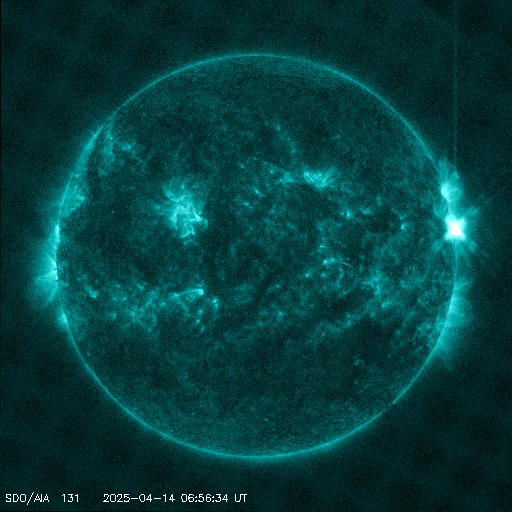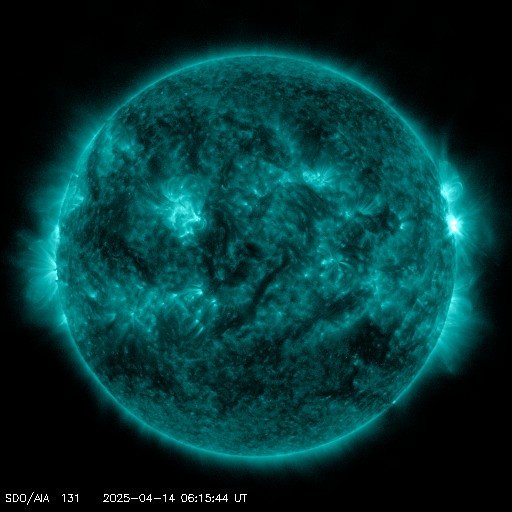Viewing archive of Saturday, 12 September 2020
Daily bulletin on solar and geomagnetic activity from the SIDC
Issued: 2020 Sep 12 1230 UTC
SIDC Forecast
Solar flares
Quiet conditions (<50% probability of C-class flares)
Geomagnetism
Quiet (A<20 and K<4)
Solar protons
Quiet
| 10cm flux | Ap | |
|---|---|---|
| 12 Sep 2020 | 069 | 003 |
| 13 Sep 2020 | 069 | 003 |
| 14 Sep 2020 | 070 | 003 |
Bulletin
The Sun was spotless. Solar activity was at very low levels and is expected to remain so.
The greater than 10 MeV proton flux was at nominal levels and is expected to remain so. The greater than 2 MeV electron flux reached moderate levels, with a maximum of 4801 pfu at 14:40UT. Despite showing signs of weakening, the electron flux has a chance to reach moderate levels again.
No earth-directed coronal mass ejections (CMEs) were observed in available coronagraphic imagery.
The earth environment entered a sector with more enhanced solar wind, after the direction of the interplanetary magnetic field (phi angle) switched from predominantly towards the Sun (negative sector) to away from the Sun (positive sector) at 14:50UT (DSCOVR). Solar wind speed gradually increased from 280 km/s to 340 km/s around 07:30UT, ending the period with values around 330 km/s. Bz was mostly negative, varying between -5 nT (around 06:00UT) and +6 nT (around 10:30UT).
Geomagnetic activity was at quiet levels, with the estimated Kp index recording an isolated unsettled episode during the 06-09UT interval. Geomagnetic activity is expected to be mostly quiet, with an isolated unsettled interval possible.
Today's estimated international sunspot number (ISN): 000, based on 25 stations.Solar indices for 11 Sep 2020
| Wolf number Catania | 000 |
| 10cm solar flux | 069 |
| AK Chambon La Forêt | 007 |
| AK Wingst | 003 |
| Estimated Ap | 002 |
| Estimated international sunspot number | 000 - Based on 35 stations |
Noticeable events summary
| Day | Begin | Max | End | Loc | Strength | OP | 10cm | Catania/NOAA | Radio burst types | |
|---|---|---|---|---|---|---|---|---|---|---|
| None | ||||||||||
Provided by the Solar Influences Data analysis Center© - SIDC - Processed by SpaceWeatherLive
All times in UTC
Current data suggests there is a slight possibility for aurora to appear at the following high latitude regions in the near future
Gillam, MB, Whitehorse, YT, Yellowknife, NTAnchorage, AK, Fairbanks, AK, Juneau, AK
Latest news
Latest forum messages
Support SpaceWeatherLive.com!
A lot of people come to SpaceWeatherLive to follow the Sun's activity or if there is aurora to be seen, but with more traffic comes higher server costs. Consider a donation if you enjoy SpaceWeatherLive so we can keep the website online!

Latest alerts
07:09 UTC - Solar flare
Moderate M4.28 flare from sunspot region 4055
06:48 UTC - Radio Blackout
Minor R1 radio blackout in progress (≥M1 - current: M1.53)
06:24 UTC - Solar flare
Moderate M1.49 flare from sunspot region 4055
06:06 UTC - Radio Blackout
Minor R1 radio blackout in progress (≥M1 - current: M1.16)
04:45 UTC - Geomagnetic activity
Active geomagnetic conditions (Kp4) Threshold Reached: 04:29 UTC
Space weather facts
| Last X-flare | 2025/03/28 | X1.1 |
| Last M-flare | 2025/04/14 | M1.4 |
| Last geomagnetic storm | 2025/04/06 | Kp5 (G1) |
| Spotless days | |
|---|---|
| Last spotless day | 2022/06/08 |
| Monthly mean Sunspot Number | |
|---|---|
| March 2025 | 134.2 -20.4 |
| April 2025 | 132.1 -2.1 |
| Last 30 days | 132.4 -10.7 |





